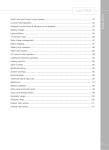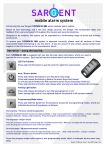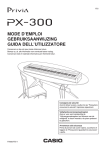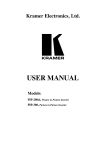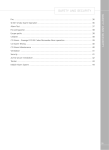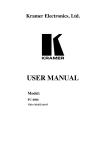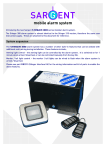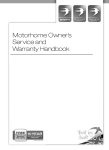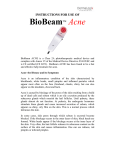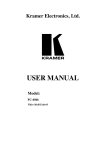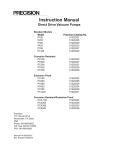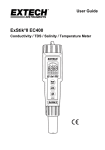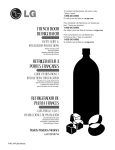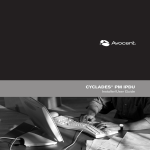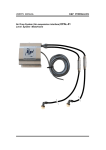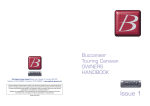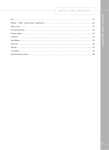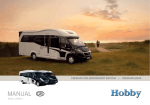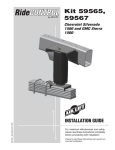Download 09 Electrics - Swift Group
Transcript
ELECTRICS Swift Command power control system (Bolero and Kon-Tiki)................................................... 88 Control Panel System Operation.............................................................................................. 90 Battery charger........................................................................................................................ 94 E L E CT RICS EC400 Power control system (Bessacarr, Escape and Rio)..................................................... 72 Fuses...................................................................................................................................... 96 Electrical faults......................................................................................................................... 101 Motorhome Battery ................................................................................................................ 107 Solar panel connection point .................................................................................................. 110 Accessory Harnessing ............................................................................................................ 111 Generator usage ..................................................................................................................... 112 Habitation relay........................................................................................................................ 112 Fault finding............................................................................................................................. 113 Cab Radio - timer setting......................................................................................................... 116 71 E LE CTRICS EC400 SERIES POWER SUPPLY SYSTEM EC400 Power control system (Bessacarr, Escape & Rio) 1. Introduction This section of the handbook will guide you through the operation of the electrical system. Further technical details are contained in section 3 or in the supporting dealer technical manual available from www.sargentltd.co.uk For the safe operation of all electrical equipment within your Leisure Vehicle it is important that you read and fully understand these instructions. If you are unsure of any point please contact your dealer / distributor for advice before use. The system has a number of key components that you will need to be familiar with before attempting to use the system, these are: • The EC400 series Power Supply Unit (PSU) - a combined mains consumer unit and 12V controller located in the front locker or bed box area. The EC400 series of power supply units include horizontal units and vertical units, further details are contained later in this document. • The EC400 series Control Panel (CP) - a remotely located user control panel used to turn circuits on and off and to display battery and water tank information. This panel uses simple straight forward controls and reliable data communication to the PSU. 2. Using the System The PSU is located in the front offside locker area or front bed box in motorhomes. 2.1 Power Supply Unit - Models A number of different PSU versions are used within the system. The operation of each model is very similar and is detailed below. 72 Combi or Alde installations Space heater /Water heater installations Red indicator – Reverse polarity indicator, lights up when the 230V supply polarity is reversed. E L E CT RICS 230V Components Green push switch – Charger switch, this switch turns the 12V battery charger on or off. “In” is on “out” is off. Amber push switch – Space heater switch, this switch turns the 230V supply to the space heater / combination heater / central heating system on or off. In is on out is off. Clear push switch – Water heater switch, this switch turns the 230V supply to the separate water heater on or off. In is on out is off. Note, If the vehicle contains a combined space & Water heater (Alde or Truma Combi) then this button is not used. Black lever switch, far left – Residual Current protection Device (RCD) and main 230V on / off switch. Yellow button, far left – RCD test button. Red lever switches, right – 3 x 10A Miniature Circuit Breakers (MCB). Please note that installations with a 3KW Alde heating system will have 2 x 10A and 1x16A MCB’s. 12V Components Black push switch, far left – System shutdown switch, this switch turns the power control system on or off. In is on out is off. Yellow push button, top right – Select button, this button is used to scroll through the display items on the LCD screen. Red push button, bottom right – Set button, this button is used to change the setting of the displayed item on the LCD screen. 12V DC circuit protection fuses. Fuse number 1 is top left; Fuse number 14 is bottom, right. See section 3.5 for full fuse allocation details. 73 E LE CTRICS EC400 SERIES POWER SUPPLY SYSTEM 2.3 Activating the System The EC400 system has a shutdown feature that should be used when the vehicle is in storage or is not being used for long periods of time. This allows the leisure electronics to be turned off when not required to save battery power. When in the off state the alarm and tracking system supplies are still active, most other supplies are turned off. Before using the system please ensure the shutdown switch is in the system on position (button in). 2.4 Connecting to the Mains 230V supply and Safety checks For your safety it is IMPORTANT that you follow these connections instructions each time your Leisure Vehicle is connected to a mains supply. This section assumes that the system is complete and that a Leisure battery has been installed (see 3.4). a. E nsure suitability of the Mains Supply. Your Leisure Vehicle should only be connected to an approved supply that meets the requirements of BS7671 or relevant harmonised standards. In most cases the site warden will hold information regarding suitability of supply. If using a generator you also need to comply with the requirements / instructions supplied with the generator. Please note that some electronic generators may not be compatible with your leisure system. Further generator operational information is contained elsewhere in this manual. b. Switch the PSU internal Power Converter OFF. Locate the green ‘Charger’ power switch on the PSU and ensure the switch is in the off position (button out) before connection to the mains supply. c. C onnect the Hook-up Lead. Firstly connect the supplied hook-up lead (orange cable with blue connectors) to the Leisure Vehicle and then connect to the mains supply. 74 d. Check Residual Current Device operation. Locate the RCD within the PSU and ensure the RCD is switched on (lever in up position). Press the ‘Test’ button and confirm that the RCD turns off (lever in down position). Switch the RCD back to the on position (lever in up position). If the test button failed to operate the RCD see section 3.10. e. Check Miniature Circuit Breakers. Locate the MCB’s within the PSU (adjacent to the RCD) and ensure they are all in the on (up) position. If any MCB’s fail to ‘latch’ in the on position see section 3.10. f. Turn the PSU ON. Locate the black ‘Shutdown’ button and ensure it is in the on position (press button in). Locate the green ‘Charger’ switch on the PSU and turn to the on position (press button in). The charger switch will illuminate when turned on. g. Check correct Polarity. Locate the ‘Reverse polarity’ indicator on the PSU and ensure that the indicator is NOT illuminated. If the indicator is illuminated see section 3.12 page 83. h. Check operation of equipment. It is now safe to operate the 12v and 230v equipment. 2.5 Control Panel - Component Layout Depending on your type of vehicle (caravan or motorhome) the control panel will vary in specification. Not all features are present in all vehicles. Please refer to the following diagrams to identify your control panel. E L E CT RICS Motorhome Control Panels EC467 Fresh water level gauge Mains supply & charger on Leisure battery selected on Awning light LED Vehicle battery selected LED Waste water level gauge Leisure battery selection button Vehicle battery selection button Leisure battery voltage gauge Vehicle battery voltage gauge Awning light on/off button Frost protect Water pump on/off button Power on/off button View levels button, press to show battery & tank levels Internal on/off button EC462 2.6 Control Panel Operation • Power Button. Press the power button to turn the leisure power on. Press the button again to turn the power off. The adjacent LED will illuminate when the power is on, and also the voltage of the selected battery will be displayed on the voltage gauge. • Pump Button. With the power on, press the pump button to turn the water pump on. Press the button again to turn the pump off. The adjacent LED will illuminate when the pump is on, and also the level of the water tank will be displayed on the water gauge. • View Levels. To display the battery voltage levels and the water tank levels on the control panel gauges, press the levels button. The display will remain illuminated for 10 seconds. It is possible to lock the display ‘on’ to allow continuous display. This can be achieved by pressing and holding the view levels button for 2-3 seconds until you hear a beep. To turn this locked feature off, either press and hold the view levels button again for 2-3 seconds or turn the power off and back on. • Battery Select. By default, the leisure battery is selected as the power source if no mains supply is present, or as the battery to be charged when the mains supply is available. To change the selected battery, press the vehicle battery select button. The selected battery is indicated by the LED’s situated to the front (vehicle) or rear (leisure) of the motorhome logo • Mains on indication. When connected to a 230v supply the LED with a “lightning strike” shown will be illuminated. 75 E LE CTRICS EC400 SERIES POWER SUPPLY SYSTEM • Charging when the vehicle engine is running. When the vehicle engine is running both the vehicle battery and the leisure battery LED’s will flash in unison to indicate that they are connected together and are being charged by the vehicle. • Cabin Lights Button. For motorhomes, with the power on, press the cabin lights button to turn the main lighting supply on or off. • Awning Light Button. For motorhomes, with the power on, press the awning light button to turn the awning light on or off. • Frost Protect Button. For motorhomes if / when fitted, with the power on, press the frost protect button to turn on the water tank heating system. The adjacent LED will illuminate to show that the tank heating system is on. 2.7 Operation while driving he EC400 system is designed to shutdown T parts of the system while the engine is running. This is to meet Electro Magnetic Compatibility (EMC) regulations and to ensure the safe operation of the caravan or motorhome. This is indicated by the two battery LED’s flashing together. lease ensure the system shutdown switch P on the PSU is in the “on” (button in) position before driving (see 2.3). This will ensure the electronic system is active and will therefore be able to control the charging process, supply the refrigerator and monitor other system circuits. n motorhomes if / when fitted, designated O 12v sockets, en-route reading lights and enroute heating will remain operational while the engine is running. 3. System Technical Information he following section provides further technical T information relating to the electrical system. You can also access the supporting technical manual from www.sargentltd.co.uk 76 3.1 Residual Current Device & Miniature Circuit Breakers Residual Current Device (RCD) Miniature Circuit Breakers (MCB’s) RCD Te st button he Residual Current Device (RCD) is basically T provided to protect the user from lethal electric shock. The RCD will turn off (trip) if the current flowing in the live conductor does not fully return down the neutral conductor, i.e. some current is passing through a person down to earth or through a faulty appliance. o ensure the RCD is working correctly, the T test button should be operated each time the vehicle is connected to the mains supply (see section 2.4) he Miniature Circuit Breakers (MCB’s) operate T in a similar way to traditional fuses and are provided to protect the wiring installation from overload or short circuit. If an overload occurs the MCB will switch off the supply. If this occurs you should investigate the cause of the fault before switching the MCB back on. MCB Rating 1 10 amps White Output wire colour 230v Sockets 2 10 amps White (Yellow for heater Extra 230v Sockets / Space Heater 2 16 amps Yellow Alde heating (EC470 PSU Only) 3 10 amps Black (Blue for water heater) Fridge / Water Heater / 12v Charger (internally connected) 3.2 Battery Charger he EC400 system incorporates an intelligent T three-stage battery charger / power converter. During stage 1 the battery voltage is increased gradually while the current is limited to start the charging process and protect the battery. At stage 2 the voltage rises to 14.4V to deliver the bulk charge to the battery. When the battery is charged, the voltage is decreased at stage 3 to 13.6V to deliver a float charge to maintain the battery in the fully charged state. The charger can be left switched on continuously as required. he battery charger / power converter also T provides power to the leisure equipment when the mains supply is connected. This module supplies DC to the leisure equipment up to a maximum of 25 Amps (300 Watts), therefore the available power is distributed between the leisure load and the battery, with the leisure load taking priority as per the following example: Lesiure Load Available power for battery charging 5A 20A 10A 15A 15A 10A 20A 5A Description E L E CT RICS The following table shows the rating and circuit allocation for the three MCB’s ! WARNING: Under heavy loads the Charger case may become hot. ALWAYS ensure the ventilation slots have a clear flow of air. Do not place combustible materials against / adjacent to the Charger. 3.3 Smart Charging n EC468 and EC469 PSU’s, the system O incorporates a smart charge feature, which monitors both leisure and vehicle batteries and automatically adjusts and directs the charger power (and solar power if a solar panel is installed) to maintain the leisure and vehicle batteries at an optimal level. 3.4 Leisure Battery a. Type / Selection or optimum performance and safety it F is essential that only a proprietary brand LEISURE battery is used with a typical capacity of 75 to 120 Ah (Ampere / hours). A normal car battery is NOT suitable. his battery should always be connected T when the system is in use. The PSU is configured to work with standard lead acid leisure batteries, and in most cases is also compatible with the latest range of Absorbed Glass Matt (AGM) batteries. Before fitting non-standard batteries please check that the charging profile described in 3.2 is suitable for the type of battery by referring to the battery documentation or battery manufacturer. 77 E LE CTRICS EC400 SERIES POWER SUPPLY SYSTEM ome vehicle installations can cater for two S leisure batteries connected in parallel. In these cases it is recommended that two identical batteries are used. o prevent over discharge, the EC400-450 T system incorporates a battery protect circuit that warns the users and then disconnects the batteries when they fall below set values. he battery feed is fitted with an inline fuse T between the battery and the electrical harness, and is usually located immediately outside the battery compartment or within 500mm of the battery. The maximum rating of this fuse is range specific, at either 30A or 40A per battery. If the power is turned on and the leisure battery level falls below 9V a warning beep will be heard and the leisure battery gauge 10V LED will flash. To cancel the warning, press the levels button. b. Installation & Removal lways disconnect the 230v mains supply A and turn the PSU green charger switch to the off position (button out) before removing or installing the battery. hen connecting the battery, ensure that the W correct polarity is observed (black is negative [-] and red is positive [+]) and that the terminals are securely fastened. Crocodile clips must not be used. ! WARNING: Explosive gases may be present at the battery. Take care to prevent flames and sparks in the vicinity of the battery and do not smoke. c. Operation / Servicing nder normal circumstances it should not U be necessary to remove the battery other than for routine inspection of the terminals and “topping up” of the battery fluid where applicable. Please see instructions supplied with the battery. Note: Do not over discharge the battery. One of the most common causes of battery failure is when the battery is discharged below the recommended level of approximately 10v. Discharging a battery below this figure can cause permanent damage to one or more of the cells within the battery. 78 If the power is turned on and the vehicle battery level falls below 10.9V a warning beep will be heard and the vehicle battery gauge 10V LED will flash. To cancel the warning, press the levels button. hese warnings will not be repeated unless the T power switch is turned off and on again. This is to ensure the warning does not become a nuisance. Voltage cut off Action after cut off Notes Vehicle 10.9v Battery selection is changed from Vehicle battery to Leisure battery. If the leisure battery is below 9v then a further warning will occur (see below). This cut off level is designed to protect the vehicle battery from over discharge. The 10.9v level ensures there is sufficient power in the battery to run the vehicle electronics and start the vehicle. This cut off only applies to power drawn from the battery by the leisure equipment; it will not protect the battery if you leave vehicle circuits switched on, such as the road lights. Leisure 9v Power is turned off This is an emergency cut off level to protect the battery from severe damage. You should not rely on this cut off level during normal operation, but manage your power consumption to a discharge level of 10v. E L E CT RICS Battery This cut off only applies to power drawn from the battery by the leisure equipment that is controlled by the control panel power switch; it will not protect the battery from discharge by permanently connected equipment. 79 E LE CTRICS EC400 SERIES POWER SUPPLY SYSTEM 3.5 12 Volt DC Fuses ! WARNING: When replacing fuses always replace a fuse with the correct value. NEVER replace with a higher value / rating as this could damage the wiring harness. If a replacement fuse ‘blows’ do not keep replacing the fuse as you could damage the wiring harness. Please investigate the fault and contact your dealer. The following table shows the fuse allocation for the 15 fuses fitted to the PSU. Please note that fuses are dependant on PSU versions, so not all fuses may be present. Fuse Rating Fuse colour 1 20 Amps Yellow 2 15 Amps Blue 3 7.5 Amps Brown * Motorhome Towing * Motorhome Marker Lights 4 15 Amps Blue * Motorhome Fridge D+ 5 10 Amps Red Extractor Fans / Heating Systems 6 10 Amps Red 12V Sockets / TV Amp / ***Radio 7 10 Amps Red Front Internal Lights 8 10 Amps Red Water Pumps / Toilet 9 15 Amps Blue * Electric Step 10 10 Amps Red * Motorhome Tank Heaters 11 10 Amps Red ** Auxiliary Supplies 12 5 Amps Tan Electronics / Fridge / Alarm 13 5 Amps Tan Oven Ignition / * Water Heater 14 10 Amps Red Rear Internal Lights 15 25 Amps Clear Charger (fitted internally to PSU) * Where Applicable / When Fitted ** M otorhome Awning / Entry lights / Map lights / Enroute Heating / Compressor Fridge / Travel Skts *** M otorhome Bathroom lights 80 Description * Motorhome Fridge 12V C468 and EC469 PSU’s incorporate a E built-in solar charge management feature, which will control the input from a separate solar panel and regulator. Depending on the charge state of the batteries, the solar power will be directed to the required battery, and continuously monitored to ensure optimum operation. For this system to operate intelligently, the shutdown button should be left switched on. If the shutdown button is turned off then the solar panel will charge the vehicle battery only. 3.7 System Status and Configuration display n the 468 & 469 PSU, the unit contains an O LCD display and two control buttons that allow system information to be viewed or settings changed. ress the top yellow ‘select’ button to change P the item being viewed. Press the bottom red ‘change’ button to change the setting. Both buttons work on a continuous loop, so if you want to return to an item or setting keep pressing the button until the required item is reached. The EC468 and EC469 PSU’s also contain a status display unit that can be used to view system information. Press the top yellow ‘select’ button to change the item being viewed. 3.8 Water System Operation he control panel pump button operates T the internal (onboard) water pump. This pump will draw water from the internal (onboard) water tank. he system also incorporates a separate T powered water inlet that can be used with an external filler pump to fill the internal (onboard) water tank. he water tanks (fresh & waste, where fitted) T incorporate a level warning feature to warn the user when the fresh water level drops below 25% or when the waste water level reaches 100%. If the water pump power is turned on and the fresh water level drops to below 25% a warning beep will be heard and the fresh gauge empty LED will flash. To cancel the warning, press the levels button. If the water pump power is turned on and the waste water level rises to full (100%) a warning beep will be heard and the waste gauge full LED will flash. To cancel the warning, press the levels button. These warnings will not be repeated unless the water pump power switch is turned off and on again. This is to ensure the warning does not become a nuisance. E L E CT RICS 3.6 Solar Charge Management 3.9 Frost Protection n vehicles fitted with water tank frost O protection, the control panel frost protect switch can be used to turn the feature on or off. ith protection on, the system monitors the W tank water temperature and water level and will control the tank heaters accordingly. If the fresh or waste water levels are less than 25% the appropriate heater will be turned off to prevent overheating or damage to the element. here are two types of system employed, both T working in a very similar way. One system uses heaters with built-in thermostats; the other uses separate temperature probes in the tank. Both types switch on at 4-5°C and off at 8-10°C 3.10 Electric Step Operation n vehicles fitted with an electric step, this O is operated by a button near the entry door. Press and release the button to move the step in or out. One press of the button will move the step out, a further press will move the step in again. If the engine is started the step will move in automatically, after a short warning buzzer. If this operation fails due to an obstacle a buzzer will sound continuously to warn that the step is still out, and therefore requires your attention. 3.11 Warnings and Alerts If the vehicle engine is started whilst the motorhome is connected to the 230v supply, a warning beep will be heard. This is to warn you to remove the 230v supply before driving away. hen the vehicle engine is running both the W vehicle battery and the leisure battery LED’s will flash in unison to indicate that they are connected together and are being charged by the vehicle. 81 E LE CTRICS EC400 SERIES POWER SUPPLY SYSTEM tep operation, if the engine is started with the S step in the out position, the step will move in automatically, after a short warning buzzer. If this operation fails due to an obstacle a buzzer will sound continuously to warn that the step is still out, and therefore requires your attention. ow water level and waste tank, if the fresh L water level drops to below 25% a warning beep will be heard and the fresh gauge empty LED will flash. To cancel the warning, press the levels button. If the waste water level rises to full (100%) a warning beep will be heard and the waste gauge full LED will flash. To cancel the warning, press the levels button. ow voltage warning and cut off, if the power L is turned on and the leisure battery level falls below 9V a warning beep will be heard and the leisure battery gauge 10V LED will flash. To cancel the warning, press the levels button. If the power is turned on and the vehicle battery is selected (being used) and the level falls below 10.9V a warning beep will be heard and the vehicle battery gauge 10V LED will flash. To cancel the warning, press the levels button. 82 POWER SUPPLY SYSTEM FAULTS Fault No 230 volt output from PSU Reverse Polarity light is illuminated on PSU Possible Cause Proposed Fix Connecting lead between the site and Leisure Vehicle not connected Check and connect lead as per 2.4C RCD switched off Reset RCD as per 2.4D RCD not operating correctly Check supply polarity; if the RCD continues to fail contact your Dealer as there is probably an equipment or wiring fault. MCB switched off Reset MCB by switching OFF (down position) then back ON (up position), if the MCB continues to fail contact your Dealer as there is probably an equipment or wiring fault. No or deficient supply from site Contact site Warden for assistance Other fault Contact your Dealer Mains Supply reversed? The reverse polarity light is designed to illuminate when the Live and Neutral supply has been reversed / crossed over. If the light illuminates there is a problem with the site supply or the cable connecting the supply to your vehicle. The light is designed to work on UK electrical supplies (where the neutral conductor is connected to earth at the sub station). If you are using your vehicle outside the UK this light may illuminate when no fault exists. In these cases consult the site warden for advice. E L E CT RICS 3.12 Common Fault Table 83 E LE CTRICS POWER SUPPLY SYSTEM FAULTS Control Panel Problems Control Panel has no display Check batteries and fuses, turn PSU shutdown switch and charger switch on and ensure mains supply is connected. Check control panel connecting lead at PSU and behind Control Panel. Contact your Dealer 12v Power turns off Battery protect feature has operated to protect the Vehicle battery and or the Leisure battery. See 3.4C Engine has been started, all equipment has been disconnected to meet EMC requirements. See 2.7 Control Panel locked / erratic function Observe control panel handling instructions Control panel software may have crashed. Reboot control panel by turning off the PSU isolate switch. Wait 30 seconds then turn the switch back on. 84 Pump not working No 230v supply Check all above Charger not switched on Turn charger switch on, switch will illuminate Battery not connected and / or charged Install charged battery as per 3.4 Power button on control panel not switched to on Turn power on at control panel Battery flat / Battery fuse blown Recharge battery, check fuses, check charging voltage is present at battery Fuse blown Check all fuses are intact and the correct value fuse is installed as per fuse table Equipment switched off / unplugged Check equipment is switched on and connected to the 12v supply PSU overheated / auto shutdown operated Reduce load on system. Allow PSU to cool down. PSU will automatically restart when cool. Other fault Contact your Dealer Fuse blown Replace fuse with correct value as per fuse table. Pump turned off Turn pump on by pressing the pump button at the control panel. Setting incorrect Both the internal and external pump feeds are controlled from the control panel. To alter the setting of the pump switch see section 3.8 E L E CT RICS No 12 volt output from PSU Ensure the setting matches your desired requirement. 3.13 Contact details Sargent Electrical Services Limited, provide a technical help line during office hours. Please contact 01482 678981 if you require technical help. For out of hour support please refer to the tech support section of the Sargent web site www.sargentltd.co.uk 85 E LE CTRICS ELECTRICAL DATA 4.Technical Data & Approvals 4.2 Motorhome Equipment EC400 Series PSU/Control Panel Outline Specification INPUT 230v 230 Volts / 0 to 16 Amps OUTPUT 230v RCD protected, 3 x MCB outputs of 10A + / - 10% Separate switched channels for water heater, space heater and charger EC470 2 x 10A MCB Outputs & 1 x 16A MCB Output (Alde systems only) INPUT 12v 2 x 20A battery inputs via 2 x 4 way connectors SOLAR INPUT 1 x Dedicated solar panel input (20 to 100W panel) via a 2 way connector OUTPUT 12v 25A total output via multiple switched channels protected by 14 fused outputs CHARGER Input 220-240 Volts AC +/10%, Frequency 50 Hz +/6%, Current 3A max. Fixing centres 128*128mm 1.2kg DC Output 13.6 to 14.4 Volts nominal, Current 25 Amps max (300 Watts). Overall size (HxWxD) 50 x 250 x 135mm Signal INPUT 4 x Fresh water level, 4 x Waste water level, 1 x Engine running, plus multiple vehicle connections Data IN / OUT CANBUS Data communication and power to Control Panel via 6 way connector IP rating IP31 Operating temperature Ambient 0 to 35°C PSU case temperature with full load 65°C Max 86 Fresh water negative sensed Waste water negative sensed Automatic shutdown and restart if overheated / overloaded EC468, EC469 PSU Overall size (HxWxD) 315 x 195 x 150mm Weight 2.9 Kg Clearances 75mm above, 50mm left & right EC462, EC467 Control Panel Overall size (HxWxD) 87 x 250 x 15mm E L E CT RICS Dimensions Fixing centres 130*75mm Weight 114 g Cut-out size (HxW) 70 x 233mm 4.3 Approvals System: BSEN 1648-1, BSEN1648-2 compliant, BS7671: 2008 compliant Residual Current Device: RCD 40A 30mA trip to BS EN 61008 Miniature Circuit Breakers: MCB’s type C 6000A breaking capacity to BSEN 60898 Electro Magnetic Compatibility (EMC) directive 2004/108/EC Certificate CE20071224-1 Integrated Charger: BS EN 60335-1/2.29, 2006/95EC, IEC61000-3.2/3:1995, 1. Low Voltage Directive: 2006/95EC TUV014900-A1, EN55022, Class B, EN55024/ Level 2 12V Operation of Electrical Items Most appliances within your product are designed to function when supplied with a 12V feed, either from a leisure battery or the on-board charger. However, customers should note that some items may have limited functionality when the battery is in a lower voltage state (i.e. circa 10V). The Swift Group makes every effort when specifying components to operate at low voltages, but is not responsible if a component fails to work at lower voltages. Components that are typically affected by low battery voltage include, but are not limited to, the pump, the radio and some lights which require higher voltages for start-up. 87 E LE CTRICS SWIFT COMMAND POWER CONTROL SYSTEM Swift Control (Bolero and Kon-Tiki) • The PX300 Intelligent Battery charger 300W 1. Introduction This section of the handbook will guide you through the operation of the electrical system. Further technical details are contained in section 3 or in the supporting technical manual available from www.sargentltd.co.uk For the safe operation of all electrical equipment within your Leisure Vehicle it is important that you read and fully understand these instructions. If you are unsure of any point please contact your dealer / distributor for advice before use. The system has a number of key components that you will need to be familiar with before attempting to use the system, these are: • The EC601 & EC651 Power Supply Unit (PSU) - a combined mains consumer unit and 12V controller located in the bed box or upper locker. • The EC620 Control Panel (CP) a remotely located user control panel used to turn circuits on and off and to display battery, water tank and other system information. This panel uses simple straightforward controls and reliable data communication to the PSU. Isolate switch 12 Volt DC fuses (under flap) • Control App and Swift Command web site - The Swift Command app can be downloaded from the Apple App store, Android Play store or Windows store, and provides many features to view information and change settings relating to the Command system, using a Bluetooth connection between phone/tablet and control system. Outside of Bluetooth range, the Swift Command website also allows control of some features, as well as providing information and historical data on your motorhome. An account for use with these services will be created and described to you by your dealer at vehicle handover – if this is for any reason not possible, or further information is required, please visit www.sargentltd.co.uk where full details are available. 2. Using the System 2.1 Power Supply Unit- Component Layout The PSU is located in the front offside bed box area or in the offside front lockers. Reverse polarity indicator Residual Current Device (RCD) RCD Test button 88 Charger switch Heating System switch Miniature Circuit Breakers (MCB’s) The EC600 system has a shutdown feature that can be used when the vehicle is in storage. This allows the leisure electronics to be turned off when not required to save battery power. When in the off state the alarm and tracking system supplies (when fitted) are still active, all other supplies are turned off. Before using the system please ensure the system shutdown switch is in the on position (button in). D) Check Residual Current Device operation. Locate the RCD within the PSU and ensure the RCD is switched on (lever in up position). Press the ‘Test’ button and confirm that the RCD turns off (lever in down position). Switch the RCD back to the on position (lever in up position). If the test button failed to operate the RCD see section 3.17. 2.3 Connecting to the Mains 230V supply and Safety checks E) Check Miniature Circuit Breakers. Locate the MCB’s within the PSU (adjacent to the RCD) and ensure they are all in the on (up) position. If any MCB’s fail to ‘latch’ in the on position see section 3.17. For your safety it is IMPORTANT that you follow these connections instructions each time your Leisure Vehicle is connected to a mains supply. This section assumes that the system is complete and that a Leisure battery has been installed (see 3.4). F) Turn the PSU ON. Locate the black ‘Shutdown’ button and ensure it is in the on position (press button in). Locate the green ‘Charger’ switch on the PSU and turn to the on position (press button in). The charger switch will illuminate when turned on. A) Ensure suitability of the Mains Supply. Your Leisure Vehicle should only be connected to an approved supply that meets the requirements of BS7671 or relevant harmonised standards. In most cases the site warden will hold information regarding suitability of supply. If using a generator you also need to comply with the requirements / instructions supplied with the generator. Please note that some electronic generators may not be compatible with your leisure system. Further generator operational information is contained elsewhere in this manual. G) Check correct Polarity. Locate the ‘Reverse polarity’ indicator on the PSU and ensure that the indicator is NOT illuminated. If the indicator is illuminated see section 3.17. E L E CT RICS 2.2 Activating the System H) Check operation of equipment. It is now safe to operate the 12V and 230V equipment. B) Switch the PSU internal Power Converter OFF. Locate the green ‘Charger’ power switch on the PSU and ensure the switch is in the off position (button out) before connection to the mains supply. C) Connect the Hook-up Lead. Firstly connect the supplied hook-up lead (orange cable with blue connectors) to the Leisure Vehicle and then connect to the mains supply. 89 E LE CTRICS SWIFT COMMAND POWER CONTROL SYSTEM 2.4 Control Panel - Component Layout Your control panel will have an appearance as below, but depending on your type of vehicle (caravan or motorhome) the control panel features will vary. Not all features are present in all vehicles. Leisure Battery Selected Warning Solar Active Vehicle Battery Selected Clock 230V Connected Heating System Active Timer Set Tank Filling ON Tank Heaters ON 230V Load Limit Active Awing Light Menu Up Light Dimming Menu Select Ceiling Lights Menu Down Water Pump Power Fresh Water Level Waste Water Level Bar-Graph Display Information Segments Multi-Function Display Power Button. Press the power button to turn the leisure power on. Press the button again to turn the power off. The adjacent LED will illuminate when the power is on, the screen backlight will turn on and system information will be shown on the LCD display. To avoid night time nuisance the LED and backlight will be turned off after a preset time, see note below. Menu Navigation Up Button. Use the menu up and down buttons to scroll through the various functions. The menu operates on a continuous loop arrangement so you can go up or down to reach all menu items. It is recommended to start in the down direction. Menu Navigation Select Button. Use the select button make a selection or to change a value or setting. This button is also used to select the display or toggle the display information on many menu items. Menu Navigation Down Button. Use the menu up and down buttons to scroll through the various functions. The menu operates on a continuous loop arrangement so you can go up or down to reach all menu items. It is recommended to start in the down direction. 90 E L E CT RICS • Leisure battery, the leisure battery voltage and charging or discharging current is displayed. Use the select button to toggle the display, with voltage on the main display whilst current (in or out of the battery is shown on the bargraph and vice-versa, current on the main display and voltage on the bargraph. • Vehicle battery, when connected the vehicle battery voltage and charging or discharging current is displayed. Use the select button to toggle the display, with voltage on the main display whilst current (in or out of the battery is shown on the bar-graph and vice-versa, current on the main display and voltage on the bar-graph. • Solar Power, the charging current from the solar panel along with the voltage of the battery it is charging is displayed. Use the select button to toggle the display, with voltage on the main display whilst current is shown on the bargraph and vice-versa, current on the main display and voltage on the bargraph. • Select Battery, press the select button toggles between the Leisure and Vehicle batteries as the power source (or battery to be charged). The selected battery is shown in the header area. • Tank Heaters on/off, (Motorhome Only) this feature enables or disables the automatic Fresh & Waste water tank frost protection system. Tank heating will start when the tank level Menu Tree • AC Limit, the AC current limiter, when enabled, will monitor the incoming AC current and if the set limit is reached the 230V heating element within the heating system will be temporarily turned off until the current falls below the set limit. Use the select button to set the limit or to turn the feature off. The AC Limit icon in the header indicated that a limit is set and will flash if the limiter is active. • Temperature & Humidity, Pressing the select button scrolls through the internal temperature, internal humidity & external temperature readings. Please note that due to the location of the internal temperature sensor there may be slight differences to the temperature shown on the heating system. • Dimmer %, this display shows the lighting dimming level and is adjusted in 5% increments. The display commences where the level was last set. Press the select button to increase the level up to 100% and then back down again to 5%. Pressing the dimming button on the control panel immediately shows this dimming value. • Heater Settings, this sub menu allow the heater controls and associated settings to be adjusted. A full explanation of the controls can be found in the heater section. • System Settings, this sub menu allows a number of system features to be configured like the Clock, Date, Key beep, Backlight time, LED time, Tank Alarms, Bluetooth Pairing etc. 91 E LE CTRICS SWIFT COMMAND POWER CONTROL SYSTEM Pump Button. With the power on, press the pump button to turn the water pump on. Press the button again to turn the pump off. The adjacent LED will illuminate when the pump is on and the level of the water tank will be shown on the screen. Interior Lights Button. With the power on, press the lights button to turn the main lighting supply on or off. Light Dimming Button. With the power on, press the dimmer button to turn the dimmed lighting on or off. Press the select button to adjust the dimmer level (the menu automatically changes to the adjustment screen). The last setting is remembered. Awning Light Button. With the power on, press the awning light button to turn the awning light on or off. The Adjacent LED will illuminate when the awning light is on. The awning light may also be controlled by a door side switch, the caravan alarm system or the motorhome locking system. Note: Display illumination. The LCD back light will illuminate for the pre-set time (default time is 30 seconds) adjustable between 5 and 120 seconds. Setting the timer to 0 seconds will force the backlight to be permanently on. The illumination of the blue LED’s adjacent to the power, pump & awning light buttons can be configured in the same way as the backlight. The screen will wake up if your hand is placed near the panel or if a button is pressed. 2.6 Operation while driving The EC600 system is designed to shutdown parts of the system while the engine is running. This is to meet Electro Magnetic Compatibility (EMC) regulations and to ensure the safe operation of the motorhome. Please ensure the system shutdown switch on the PSU is in the on (button in) position before driving (see 2.2). This will ensure the electronic system is active and will therefore be able to control the charging process, supply the refrigerator and monitor other system circuits. On motorhomes if / when fitted, designated 12V sockets, en-route reading lights and enroute heating will remain operational while the engine is running. With the engine running the screen will show ENGINE RUNNING, the leisure and vehicle battery icons will be displayed to indicate they are being charged and the charging voltage will be show in the main display. 92 The following section provides further technical information relating to the electrical system. You can also access the supporting technical manual from www.sargentltd.co.uk 3.1 Residual Current Device & Miniature Circuit Breakers Residual Current Device (RCD) Miniature Circuit Breakers (MCB’s) The following table shows the rating and circuit allocation for the three MCB’s Output Wire colour MCD Rating 1 10 Amps White 230v Sockets 2 16 Amps White (Yellow for heater) Extra 230V Sockets/ heating System 3 10 Amps Black Fridge/ Charger/ Auxiliary devices RCD Test button Description E L E CT RICS 3 System Technical Information 3.2 Generator Usage The Residual Current Device (RCD) is basically provided to protect the user from lethal electric shock. The RCD will turn off (trip) if the current flowing in the live conductor does not fully return down the neutral conductor, i.e. some current is passing through a person down to earth or through a faulty appliance. To ensure the RCD is working correctly, the test button should be operated each time the vehicle is connected to the mains supply (see section 2.3) The Miniature Circuit Breakers (MCB’s) operate in a similar way to traditional fuses and are provided to protect the wiring installation from overload or short circuit. If an overload occurs the MCB will switch off the supply. If this occurs you should investigate the cause of the fault before switching the MCB back on. Caution should be used before connecting a generator to your caravan or motorhome. ! WARNING: Never start or stop the generator while electrical loads are connected and switched on. Start the engine, let it stabilise and then connect the electrical load. To stop the engine, disconnect the electrical load and let engine stabilise before switching off Whilst some generators use electronic inverter technology, others use a more basic principle to generate the 230V supply. Preference should be to choose a generator which produces a consistent sinusoidal wave form with accurate voltage control. The Reverse Polarity warning light on the PSU may illuminate when using a Generator. This is a normal side effect when using some types of generator. Instead of connecting the neutral conductor to earth, some generators centre tap the earth connection making both neutral and live conductors 110V above earth. This 110V difference causes the neon polarity indicator to illuminate. In most cases it is safe to use a generator, but please consult the generator handbook for further information. 93 E LE CTRICS SWIFT COMMAND POWER CONTROL SYSTEM 3.3 Battery Charger 3.4 Leisure Battery The system incorporates an intelligent threestage battery charger. A) Type/Selection For optimum performance and safety it is essential that only a proprietary brand LEISURE battery is used with a typical capacity of 75 to 120 Ah (Ampere / hours). A normal car battery is NOT suitable. This battery should always be connected when the system is in use. During stage 1 the battery voltage is increased gradually while the current is limited to start the charging process and protect the battery. At stage 2 the voltage rises to 14.4V to deliver the bulk charge to the battery. When the battery is charged, the voltage is decreased at stage 3 to 13.6V to deliver a float charge to maintain the battery in the fully charged state. The charger can be left switched on continuously as required. The battery charger / power converter also provides power to the leisure equipment when the mains supply is connected. This module supplies DC to the leisure equipment up to a maximum of 25 Amps (300 Watts), therefore the available power is distributed between the leisure load and the battery, with the leisure load taking priority as per the following example: Leisure Load Available power for battery charging 5A 20A 10A 15A 15A 10A 20A 5A Vboost Charge Voltage Vflt 100% Charge Current Charge Indicator Constant Current Constant Voltage Stage 1 Stage 2 Red Stage 3 Green ! WARNING: Under heavy loads the Battery Charger case may become hot. ALWAYS ensure the ventilation slots have a clear flow of air. Do not place combustible materials against / adjacent to the charger. 94 The PSU is configured to work with standard lead acid leisure batteries, and in most cases is also compatible with the latest range of Absorbed Glass Matt (AGM) batteries. Before fitting non-standard batteries please check that the charging profile described in 3.3 is suitable for the type of battery by referring to the battery documentation or battery manufacturer. Some vehicle installations can cater for two leisure batteries connected in parallel. In these cases it is recommended that two identical batteries are used. The battery feed is fitted with an inline fuse between the battery and the electrical harness, and is usually located immediately outside the battery compartment or within 500mm of the battery. The maximum rating of this fuse is 20A per battery. If a single battery is fitted to a motorhome, this fuse could be up to 40A, however if two batteries are fitted each battery should be fused at a maximum of 20A. B) Installation & Removal Always disconnect the 230V mains supply and turn the PSU green charger switch to the off position (button out) before removing or installing the battery. When connecting the battery, ensure that the correct polarity is observed (black is negative [-] and red is positive [+]) and that the terminals are securely fastened. Crocodile clips must not be used. ! WARNING: Explosive gases may be present at the battery. Take care to prevent flames and sparks in the vicinity of the battery and do not smoke. Note: Do not over discharge the battery. One of the most common causes of battery failure is when the battery is discharged below the recommended level of approximately 10V. Discharging a battery below this figure can cause permanent damage to one or more of the cells within the battery. Battery Voltage cut off Action after cut off To prevent over discharge, the EC600 system incorporates a battery protect circuit that warns the users and then disconnects the batteries when they fall below set values. If a warning is active a beep will be emitted by the control panel and information will be shown on the screen. To cancel the warning, press the select button. These warnings will not be repeated unless the power switch is turned off and on again. This is to ensure the warning does not become a nuisance. E L E CT RICS C) Operation / Servicing Under normal circumstances it should not be necessary to remove the battery other than for routine inspection of the terminals and “topping up” of the battery fluid where applicable. Please see instructions supplied with the battery. Notes Vehicle 10.9V Battery selection is changed from Vehicle battery to Leisure battery. If the leisure battery is below 9v then a further warning will occur (see below). This cut off level is designed to protect the vehicle battery from over discharge. The 10.9V level ensures there is sufficient power in the battery to run the vehicle electronics and start the vehicle. This cut off only applies to power drawn from the battery by the leisure equipment; it will not protect the battery if you leave vehicle circuits switched on, such as the road lights. Leisure 9V Power is turned off This is an emergency cut off level to protect the battery from severe damage. You should not rely on this cut off level during normal operation, but manage your power consumption to a discharge level of about 11.5V. This cut off only applies to power drawn from the battery by the leisure equipment that is controlled by the control panel power switch; it will not protect the battery from discharge by permanently connected equipment. 95 E LE CTRICS SWIFT COMMAND POWER CONTROL SYSTEM 3.5 12 Volt DC Fuses ! WARNING: When replacing fuses always replace a fuse with the correct value. NEVER replace with a higher value / rating as this could damage the wiring harness. If a replacement fuse ‘blows’ do not keep replacing the fuse as you could damage the wiring harness. Please investigate the fault and contact your dealer. The following table shows the fuse allocation for the 13 fuses fitted to the PSU. Please note that fuses are dependant on PSU versions, so not all fuses may be present. Fuse Rating Fuse colour 1 25 Amps White Charger 2 7.5 Amps Brown Permanent 12V/ Alarm/ Fridge Electronics/ Alde Heating 3 10 Amps Red 12V Sockets/ TV Amplifier 4 10 Amps Red Extractor Fans/ Truma Heating 5 5 Amps Tan Appliances/Hob Ignition/Toilet 6 10 Amps Red Water Pumps/Tank Heaters 7 7.5 Amps Brown Lighting, Main Lights & Dim Channel 1 8 5 Amps Tan Lighting, Entry Light & Dim Channel 2 9 10 Amps Red Spare Outputs/ Marker Lights/ (En-Route Sockets & Lights) 10 10 Amps Red Auxiliary/ Awing Light/ Electric Step 11 20 Amps Yellow Fridge 12V 12 15 Amps Blue Towing 12V 13 15 Amps Blue Fridge D+ Note: Fuses (2-13) have a Red LED below them which provides indication that the fuse has blown. The charger fuse has a green LED which Indicates that the charger is working. 96 Description Fuse Rating Fuse colour Battery 1 20 Amps Yellow Fuse remotely located near battery Description Battery 2 20 Amps Yellow Fuse remotely located near battery 2 (where fitted) E L E CT RICS The following table shows details of the fuse(s) located at the Leisure battery. See also 3.4A The following table shows details of the fuse(s) located at the Road Light fuse box | (caravans only) Fuse Rating Fuse colour 1 20 Amps Yellow Description Fridge Supply 2 5 Amps Tan Left Hand Tail Lights 3 5 Amps Tan Right Hand Indicators 4 5 Amps Tan Fog Lights 5 Spare location 6 20 Amps Yellow 7 5 Amps Tan Right Hand Tail Lights Car Battery Supply 8 5 Amps Tan Left Hand Indicators 9 7.5 Amps Brown 10 5 Amps Tan Stop Lights Reverse Lights 3.6 Solar Charge Management 3.7 Mains Charging The EC601/651 PSU incorporates a built-in solar charge management feature, which will monitor the input from a separate solar panel and regulator. The Solar Active symbol will be displayed on the control panel when there is an amount of energy available to charge the battery. The voltage and current produced from the regulator can be viewed on the multifunction display by selecting the Solar Power menu item. Depending on the charge state of the batteries, the solar power will be directed to the required battery and continuously monitored to ensure optimum operation. The EC651 PSU incorporates a smart charge feature, which monitors both leisure and vehicle batteries and automatically adjusts and directs the charger power (and solar power if a solar panel is installed) to maintain the leisure and vehicle batteries at an optimal level. 97 E LE CTRICS SWIFT COMMAND POWER CONTROL SYSTEM 3.8 Water Pump Operation 3.10 AC Current Limiter Operation The EC620 control panel pump button operates the internal water pump drawing water from an internal tank if fitted, or an external container when no internal tank is fitted. The EC600 system features a 230V current monitoring system which allows the mains hook up current to be displayed on the control panel and the resolution of the display is 0.5A. A current limit setting can be activated which if reached will switch off the electric elements in the heating system, until such time as the current drops and the elements will be switched back on. An example of this is if a kettle was to be operated whilst the heating was on and the current limit was reached then the heater electric element would be temporarily switched off, when the kettle had boiled then the heater element would be switched back on automatically. The water tanks (fresh & waste) incorporate a level warning feature to warn the user when the fresh water level drops below 25% or when the waste water level reaches 100%. If the water pump power is turned on and the fresh water level drops to below 25% a warning beep will be heard and a message will be displayed on the control panel. To cancel the warning, press the select button. If the water pump power is turned on and the waste water level rises to full (100%) a warning beep will be heard and a message will be displayed on the control panel. To cancel the warning, press the select button. This feature is particularly useful when abroad on a low current supply. A warning that the limit has been reached is displayed on the control panel. These warnings will not be repeated unless the water pump power switch is turned off and on again. This is to ensure the warning does not become a nuisance. Setting the value to OFF will disable this feature. 3.9 Water Tank Heaters (frost protection) Operation 3.11 Lighting and Dimming Operation The EC651 features the ability to switch on water tank heater to provide frost protection for the fresh and waste tanks. The tank heater symbol is displayed on the control panel when this feature is enabled. The tank heaters will only operate if there is over 25% in the relevant water tank and the external temperature sensor detects that the temperature falls below 2 degrees C. If the temperature rises above this level the heaters will be switched off but the feature will remain on. The Swift Command App can be used to adjust this feature. The system contains up to two dimming channels for groups of lights which can be controlled by the dimmer button. Some motorhome models also feature an additional furniture mounted dimming control. The awning light on a caravan can be controlled by a number of items within the caravan, the local switch adjacent to the entry door, the alarm system lighting button, the control panel awning light button and the App. Each item can toggle the light on and off. The awning light on a motorhome can again be controlled by a number of items, the local switch adjacent to the entry door, the control panel awning light button, the App and the lock and unlock system (dependant on system setting being set to do so). Each item can toggle the light on and off. The Swift Command App can be used to both configure and adjust the lighting and dimming. 98 There are a number of heating systems that can be controlled by the EC600. The system will be preconfigured by the manufacturer. The following menu items are only available in Timer control mode, this example refers to models equipped with Alde heating systems, other heating systems will have similar controls but some options may vary. E L E CT RICS 3.12 Heating Controls Scroll to the Heating Settings and press select to set or adjust the following items: Menu Item Control Description Set to Manual to use the controls supplied by the heating appliance manufacturer. Set to Timer to control the appliance by the control panel with the settings below. Set to Remote control the appliance by the Swift Command app. The following menu items are only available when in Timer control mode Note: When heating control method is set to 'timer or 'remote' the ALDE control panel will display information but cannot be used to adjust settings. Electric Set the electric element to off, 1KW, 2KW or 3KW Gas Set gas heating on or off Timer 1 Set the timer 1 event time. This setting adjusts in 15 minute increments and uses the 20 hour clock. Example 07:30 T1 Heating Set the timer 1 heating temperature. Example 22 deg C This setting can be off, or 5 through to 30 degrees C T1 H/Water Set the timer 1 hot water temperature.This setting can be off, 40 deg C, 60 deg C or Boost Example 40 deg C The menu now repeats for timer 2 through to timer 4 Exit Settings When timer 4 is completed the exit settings item is reached. Press the select button to exit and save the settings. The timer example above will set the heating to 22 degrees C and the hot water to 40 degrees C at 7:30 in the morning. 99 E LE CTRICS SWIFT COMMAND POWER CONTROL SYSTEM 3.13 Other Controls The main control panel will display the software version number of both the Control Panel and the PSU. On the EC620 menu item press the select button to display software information. 3.14 Electric Step Operation On vehicles fitted with an electric step, this is operated by a button near the entry door. Press and release the button to move the step in or out. One press of the button will move the step out; a further press will move the step in again. If the engine is started the step will move in automatically, after a short warning buzzer. If this operation fails due to an obstacle a buzzer will sound continuously to warn that the step is still out, and therefore requires your attention. 3.15 Bluetooth Pairing Using the control panel, access the System Settings menu and then scroll to the Bluetooth pairing section. Press the select button to start pairing, the power button LED will flash to indicate the pairing mode. You can now pair your device to the system following the devices instructions to add a Bluetooth item. Pairing remains on for 1 minute and is then turned off automatically. Note: Up to 4 Bluetooth devices can be paired. It is possible to clear all paired devices, to pair alternative devices. 100 The system incorporates a number of warnings that are active at specific times. These are summarised below, and also covered by relevant sections of this manual. When a warning is active a triangle will be displayed in the control panel header area. Warning Fresh water level low When With pump turned on and fresh water level low (less than 25% full). E L E CT RICS 3.16 System Warnings Type Message on screen and 30 second audible beep Only available when an on-board tank is fitted Waste water With pump turned on and waste Message on screen and 30 second audible level full water level full. beep Leisure battery voltage low Leisure battery voltage high Vehicle battery warnings Engine running Step extended Mains lead (hook-up cable) still connected / plugged in Only available when an on-board tank is fitted. With control panel power on Message on screen and 30 second audible and leisure battery selected (as beep. active battery) and the voltage level falls below 10V. Message on screen and 30 second audible With control panel power on and leisure battery selected (as beep. If no action taken after 30 seconds active battery) and the voltage then the system will switch the power off to prevent severe discharge of the battery. level is below 9V. Note: T his is an emergency cut off level to protect the battery from severe damage. You should not rely on this cut off level during normal operation, but manage your power consumption to a discharge level of 11.5V or above. This cut off only applies to power drawn from the battery by the leisure equipment that is controlled by the control panel power switch; it will not protect the battery from discharge by permanently connected equipment. With control panel power on or Message on screen and repeated beeps off and leisure battery is selected from the control panel. The power is (as active battery) and the voltautomatically turned off. The beeping will not age level rises above 15V. stop until the fault is cleared. If the vehicle battery is selected instead of the leisure battery, then similar warnings to those described above are applied to the vehicle battery. The vehicle battery low warning level is 10.9V. When the engine is started the Message on screen, Leisure & Vehicle system power will be turned off. battery symbols indicating both batteries are connected for charging. The charging voltage is also shown on screen. Step extended and engine Message on screen and warning buzzer started Step jammed or obstructed When the engine is started and Message on screen and repeated beeps the mains cable is still plugged from the control panel. The beeping will not in and the charger is switched stop until the hook-up lead is removed. on. 101 E LE CTRICS SWIFT COMMAND POWER CONTROL SYSTEM 3.17 Common Fault Table Fault No 230 volt output from PSU Possible Cause Proposed Fix Connecting lead between the site and Leisure Vehicle not connected Check and connect lead as per 2.3C RCD switched off Reset RCD as per 2.3D RCD not operating correctly Check supply polarity; if the RCD continues to fail contact your Dealer as there is probably an equipment or wiring fault. MCB switched off Reset MCB by switching OFF (down position) then back ON (up position), if the MCB continues to fail contact your Dealer as there is probably an equipment or wiring fault. No or deficient supply from site Contact site Warden for assistance Other fault Contact your Dealer Mains Supply reversed? The reverse polarity light is designed to illuminate when the Live and Neutral supply has been reversed / crossed over. If the light illuminates there is a problem with the site supply or the cable connecting the supply to your vehicle. The light is designed to work on UK electrical supplies (where the neutral conductor is connected to earth at the sub station). If you are using your vehicle outside the UK this light may illuminate when no fault exists. In these cases consult the site warden for advice. Generator being used ‘The Reverse Polarity warning light is on when using my Generator’. This is a normal side effect when using some types of generator. Instead of connecting the neutral conductor to earth, some generators centre tap the earth connection making both neutral and live conductors 110V above earth. This 110V difference causes the neon polarity indicator to illuminate. In most cases it is still safe to use the generator, but please consult the generator handbook for further information. Pump not Fuse blown Replace fuse with correct value as per fuse table. working Pump turned off Turn pump on by pressing the pump button at the control panel. Setting incorrect Both the internal and external pump feeds are controlled from the control panel. To alter the setting of the pump switch see section 3.8 Reverse Polarity light is illuminated on PSU Ensure the setting matches your desired requirement. 102 Control Panel has no display Check batteries and fuses, turn PSU isolate switch and charger switch on and ensure mains supply is connected. Check control panel connecting lead at PSU and behind Control Panel Contact your Dealer 12v Power turns off Battery protect feature has operated to protect the Vehicle battery and or the Leisure battery. See 3.4C Over voltage protection has been activated, the control panel will display a warning. E L E CT RICS Control Panel Problems Engine has been started, all equipment has been disconnected to meet EMC requirements. See 2.6 No 12 volt output from PSU Control Panel locked / erratic function Observe control panel handling instructions. Control panel software may have crashed. Reboot control panel by turning off the PSU isolate switch. Wait 30 seconds then turn the switch back on. No 230v supply Check all above Charger not switched on Turn charger switch on, switch will illuminate Battery not connected and / or charged Install charged battery as per 3.4 Power button on control panel not switched to on Turn power on at control panel Battery flat / Battery fuse blown Recharge battery, check fuses, check charging voltage is present at battery Fuse blown Check all fuses are intact and the correct value fuse is installed as per fuse table Equipment switched off / unplugged Check equipment is switched on and connected to the 12V supply Other fault Contact your Dealer Lights not Fuse/s blown Replace fuse with correct value as per fuse table. working Lights turned off Turn Lights on by pressing the lights button, use dimmer at the control panel. Communications not working Bluetooth not paired Using System Settings menu, select Bluetooth Pair option Bluetooth not active on Device Ensure that the handheld device has Bluetooth switched on and that the device supports the Bluetooth 4 standard (BLE) Bluetooth out of range Ensure the handheld device is within 7M of the middle of the caravan/motorhome 103 E LE CTRICS SWIFT COMMAND POWER CONTROL SYSTEM 3.18 Contact Details Sargent Electrical Services Limited provide a technical help line during office hours. Please contact 01482 678981 if you require technical help. For out of hour support please refer to the tech support section of the Sargent web site www.sargentltd.co.uk 4 Remote Access & Control 4.1 Swift Command App The Swift Command app can be down loaded from the Apple App Store, the Android Play store or the Windows store. Your dealer will be able to demonstrate the app and the many features that it provides. Some of the key features are; • Power information and Control • Lighting Control • Water System Control • Heating Control • Tracking Usage information The EC600 system contains Mobile SIM with 36 month contract, which commences upon activation at the Dealership when a customer is assigned to the caravan/motorhome. Below is a list of the countries covered by the SIM under a fair usage policy, a complete list is available at request. Austria, Belgium, Bulgaria, Cyprus, Czech Republic, Denmark, Estonia, Finland, France, Germany, Greece, Hungary, Iceland, Ireland, Italy, Latvia, Liechtenstein, Lithuania, Luxembourg, Netherlands, Malta, Norway, Poland, Portugal, Romania, Slovakia, Slovenia, Spain, Sweden, United Kingdom 4.4 Replacement Parts The Control panel contains a small lithium battery to maintain the clock when no other energy supplies are available this will last in excess of 5 years under normal conditions. The battery is a CR2032 3.0V. • User Manual The EC640 Communication module contains a special backup battery pack which should last in excess of 3 years under normal conditions. The pack part number is 16308 available from Sargent. • Swift Website Link 4.5 Updates Before you can use the App with your caravan or motorhome you will need to create an account and sign up to the free communication service. This is a simple process and will be explained further by your dealer at the vehicle handover. Additional information is available at www.sargentltd.co.uk. From time to time there may be updates to the system software; these updates will be done at service intervals by your dealership. • Alerts & Notifications • Account and System Settings 4.2 Swift Command Web usage & Description In addition to the mobile App, you can also use the same account and login details to access the Swift Command web site, www.swiftcommand.co.uk 104 4.3 Swift Command SIM Coverage & Here you can update and amend your details, look at tracking information and history, review system information and historical data as well as changing some system options and settings. 5.1 Caravan Equipment – EC601, EC651, EC620, EC630 & EC640 Control Equipment Outline Specification INPUT 230v 230 Volts / 0 to 16 Amps OUTPUT 230V RCD protected, 2 x MCB outputs of 10A & 1 x MCB output of 16A Separate switched channels for heating system and charger INPUT 12V 2 x 20A battery inputs via 2 x 4 way connectors SOLAR INPUT 1 X Dedicated solar panel input (20 to 150W panel) via a 2 way connector OUTPUT 12V 25A total output via multiple switched channels protected by 13 fused outputs Integrated CHARGER Input 220-240 Volts AC +/- 10%, Frequency 50 Hz +/- 6%, Current 3A max. DC Output 13.6 to 14.4 Volts nominal, Current 25 Amps max (300 Watts). Signal INPUT 4 x Fresh water level, 4 x Waste water level, 1 x Engine running, plus multiple vehicle connections, sensor inputs for temperature & humidity Data IN / OUT CANBUS Data communication and power to Control Panel via 6 way connector. CI-Bus Data communication to CI-Bus enabled devices via RJ11/12 connector IP rating IP31 Operating temperature Ambient 0 to 35° Celsius Charger case temperature with full load 65° C Max Automatic shutdown and restart if overheated / overloaded Overall size (HxWxD) 180 x 305 x 135mm Weight 3.8 Kg E L E CT RICS 5 Technical Data & Approvals + / - 10% Fresh water negative sensed Waste water negative sensed Dimensions EC601 & EC651 PSU Clearances 75mm above, 50mm left & right EC620 Control Panel Overall size (HxWxD) 93 x 180 x 32mm Cut-out size (HxW) 82 x 165mm Fixing centres 166mm X 26MM Weight 150g EC630 Comms Overall size (HxWxD) 55 x 116 x 85mm Weight 550g Overall size (HxWxD) 60 x 27 x 14mm Weight 80g Module EC640 Sensor 105 E LE CTRICS SWIFT COMMAND POWER CONTROL SYSTEM 5.2 Approvals System: BSEN 1648-1, BSEN1648-2 compliant, BS7671: 2008 compliant Residual Current Device: RCD 40A 30mA trip to BS EN 61008 Miniature Circuit Breakers: MCB’s type C 6000A breaking capacity to BSEN 60898 Electro Magnetic Compatibility (EMC) directive 2004/108/EC Certificate CE20071224-1 Integrated Charger: BS EN 60335-1/2.29, 2006/95EC, IEC61000-3.2/3:1995, 1. Low Voltage Directive: 2006/95EC TUV014900-A1, EN55022, Class B, EN55024/ Level 2 5.2 Declaration of Conformity Equipment: Leisure Power Control System Model name: EC601, EC651, EC620 & PX300 I hereby declare that the equipment named above has been designed to comply with the relevant sections of the above referenced approvals. The unit complies with all essential requirements of the Directives. Signed Date: Name Position Manufacturer I L Sargent Technical Director Sargent Electrical Services Ltd Unit 39, Tokenspire Business Park Woodmansey, Beverley East Yorkshire, United Kingdom Whilst every effort has been made to ensure the accuracy and completeness of this document, no guarantee is given against errors oromissions. This document may be updated / improved orver time therefore please check with your dealer / supplier for update information or visit www.sargentltd.co.uk 106 M0TORHOME BATTERY ! WARNING: Use precaution when removing or replacing the battery, as batteries contain acid liquids which can cause severe injuries and damage when handled incorrectly. Refer to the cleaning and maintenance section. Please also take into consideration when manoeuvring a battery, that the weight may be in excess of 20kg. Your motorhome has been fitted with one or two leisure batteries depending on size of vehicle and expected electrical loads. The battery will be housed in one of three ways: Within a floor mounted compartment Within a side mounted compartment Retained beneath the drivers seat Floor mounted and side mounted compartments are designed to hold the battery securely and to contain any electrolyte (acid) spillage. Under floor compartments are sealed from the habitation compartment and a breather pipe is fitted to ensure any build up of explosive gases (hydrogen) is vented to the outside. If a breather pipe is fitted it is important to ensure that any replacement batteries are also fitted with a breather pipe. The battery or batteries should only be positioned in the appropriate compartment, and be properly secured before travelling. Note: The batteries fitted to your motorhome in floor mounted or side mounted compartments must be kept upright. When a leisure battery has been factory installed below the driver’s seat, the battery type used is specific to that installation, and is of a type (Sealed AGM) that allows a battery to be installed in a vertical or horizontal orientation. Due to the construction of this type of battery, it is not necessary to vent the battery to the outside, and there is no requirement to check and maintain electrolyte levels. Note: If an AGM battery is replaced, it must be replaced by an equivalent AGM battery which is suitable for a horizontal installation, and does not require venting to the outside. E L E CT RICS Motorhome battery It is recommended that a good quality leisure battery is always connected when the motor home electrical system is in use. Leisure batteries are a deep cycling rechargeable heavy duty 12v battery designed to provide power for lights and other electrical appliances. It should be remembered that batteries suitable for the electrical demands of a motorhome differ in design from those for use with a car, and whilst the system may operate with a car battery it is strongly recommended that only a rechargeable leisure type battery, maintained in good condition, is used. The battery should be kept topped up (charged) at all times. If two leisure batteries are fitted additional care is needed, as one battery deteriorates this can reduce the lifespan of the other. Replacement batteries should be a proprietary brand leisure battery with a minimum 75Ah capacity. Replacement batteries should be checked dimensionally before purchasing, to ensure fitment within the battery compartment, as brands vary in size. ! WARNING: When connecting the battery, ensure that the correct polarity is observed (black is negative and red/ brown is positive) and that the terminals are securely fastened. Under normal circumstances it should not be necessary to remove the battery other than for routine inspection of terminals and (for nonAGM batteries) ‘topping up’. ! WARNING: Explosive gases may be present at the battery. Take care to prevent flames and sparks in the vicinity. Your motorhome has been fitted with an in-line fuse between the battery terminal and the power supply unit. 107 E LE CTRICS MOTORHO ME BATTERY Do not use a higher rated fuse as this may cause damage to your motorhome. ! WARNING: Switch off all appliances and lamps before connecting or disconnecting the battery. Smoking is prohibited around the battery compartment. To preserve the life of your leisure battery and charger please observe the following: 1. D o not leave all 12v lights powered at the same time as this will drain your leisure battery more rapidly. 2. If all 12v lights must be powered together, ensure the battery is ‘in-circuit’ and that the battery charger is turned on. 3. F or optimum performance use the transformer/charger unit with a leisure battery attached. Please note the auxiliary battery or batteries supplied with your motorhome may not be fully charged and should be charged for a minimum of 24 hours before use. Battery performance may be affected by a number of things such as ambient temperature, age, state of charge etc. Cleaning and maintenance (Floor mounted battery compartment) • Use protective clothing and glasses when handling a leaking battery, and avoid direct contact to the skin, eyes and respiratory organ. • Should a battery leakage occur, please act according to the instructions supplied by the manufacturer of the battery. Act with caution as caustic substances are present in the battery. • Always remove the battery and the power cable before carrying out any maintenance of the product. • Before removing the clamps switch off all appliances. • Use a soft cloth or sponge and a non-acid/ abrasive detergent when cleaning the Battery Box and Soft Tray. 108 • To check if any acid is present in the Soft Tray (non-AGM batteries), simply press it softly. A strong smell from the Soft Tray may also indicate spilled acid. The battery can be filled again with acid collected from the Soft Tray. Always treat spilled battery acid as hazardous waste. Dispose of spilled battery acid according to the local and national regulations. • At the beginning of each season or extensive travelling, check the Soft Tray for faults and replace if necessary. • The cleaning of the Battery Box and Soft Tray should only be done after all power sources have been switched off, in order to prevent a hazardous situations. Side opening battery box The Battery Box is intended to accommodate an auxiliary battery in your motorhome. The Battery Box has a CE socket to connect to a 230 V power supply. ! WARNING: • Use precaution when mounting the battery, as batteries contain acid liquids which can cause severe injuries and damage when handled incorrectly. Refer to the instructions on the battery. • No smoking is allowed in the area of the Battery Box! • Please note that the CE socket has a max of 16 amp. This product meets the latest version of the EN 1648 part 1 and 2 standard. Before placing the battery inside the Battery Box, the battery should be placed in either the battery bag or the Soft Tray and rested on the ground adjacent to the Battery Box. Carefully connect the electrical wires (the red cable attaches to the + pole and the black cable to the - pole of the battery). Note: Incorrect connection of the cables will cause a short circuit with potential hazardous consequences. After mounting the terminals, lift the battery The maximum battery size that can be fitted is 225mm high (including terminals) x 175mm deep x 353mm wide. The depth and width dimensions include the rim around the bottom used for securing the battery. Note: Batteries that are not foot mounted, i.e. without a rim can still be fitted, but check first that they will fit within the battery box and can be secured before purchasing. • Before removing the clamps switch off all electrical and gas appliances. • Use a soft cloth or sponge and a non-acid/ abrasive detergent when cleaning the battery box, soft tray or bag. E L E CT RICS together with the Soft Tray into the middle of the Battery Box compartment. Push the battery to the back of the Battery Box. The battery is secured by a strap (figure A). When attaching the 230 volt cable on the CE socket, the maximum recommended thickness of the cable is 10 mm. When closing the door, the attached cable is to be fed through the slot in the door. • To check if any acid is present in the soft tray or bag, simply press it softly. A strong smell from the soft tray may also indicate spilled acid. Always treat spilled battery acid as hazardous waste. Dispose of spilled battery acid according to the local and national regulations. • Before the camping season or extensive travelling, check the soft tray for faults and replace if necessary. • The cleaning of the battery box and soft tray should only be done after all power sources have been switched off, in order to prevent a hazardous situations. Figure A Cleaning and maintenance (Side mounted battery compartment) • Use protective clothing and glasses when handling a leaking battery, and avoid direct contact to the skin, eyes and respiratory organ. • Should a battery leakage occur, please act according to the instructions supplied by the manufacturer of the battery. Act with caution as caustic substances are present in the battery. • Always remove the battery and the power cable before carrying out any maintenance of the product. 109 E LE CTRICS SOLAR PANEL CONNECTION Solar panel connection point or Solar panel fitment Factory fitted Solar Energy System Depending on specification, a solar panel connection point, or a solar panel and regulator, will be installed in the motorhome. Solar Panel Connection Point If a connection point only has been included in the motorhome harness, a solar panel using the provision must provide a fused and regulated output. From the provided connection the supply is taken to the EC400 power supply unit. This facility is designed to be used with a maximum solar panel size of 100 watts – if a solar panel (or panels) of output greater than 100 watts are required, please contact Sargent Electrical Services or the Swift Group for further advice. Solar charge directed to the power supply unit can then be distributed to the leisure battery, vehicle battery, or each battery in turn. For further details of selecting which battery receives the solar charge, please see the EC400 series instructions. Please note that solar charge can only be directed to both batteries in this way if the System Shutdown button is ON – if System Shutdown is OFF, any available solar charge will be directed to the vehicle battery only. Solar panel installations should be undertaken by trained technicians who are familiar with the systems involved. Particular care should be taken when making connections to solar panels, which can generate high voltages ahead of a regulator when exposed to light. Motorhomes without factory fit solar energy systems will have two way connectors present close to the leisure battery, and/or at a high level within furniture (i.e within wardrobe, either visible or behind a removable cover). The output from a regulator, rated to suit the chosen solar panel, should be connected to this point. 110 Depending on specification, your motorhome may be fitted with a solar panel of up to 120W, and if a solar panel is fitted then a suitable solar regulator will also be installed. This solar panel and regulator may provide additional 12v power whenever sunlight is available to the panel, and this will be directed to the EC400/ EC600 power supply unit. Conditions allowing, and depending on the settings chosen in the EC400/EC600 power supply unit, the system can keep the leisure battery and vehicle battery 'topped up' during storage, and will provide a daily boost to the leisure battery when camping without a mains 230V supply. Regulator operation The regulator operates automatically, turning on and off as required to charge and operate. When the solar panel is exposed to a source of sunlight the regulator tarts to operate. When the voltage from the panel reaches a usable level, the Panel Output LED will flash indicating that the battery is being charged (see battery charging above). If insufficient power is being generated by the solar panel the regulator will turn off. The regulator checks the solar panel output every 30 seconds and turns on/off as required. On overcast days when the solar panel output is minimal the regulator can still deliver a small charge, and in this mode the LED's are not illuminated to conserve power. Control Panel When the solar panel is operating the leisure battery voltage display on the control panel will increase, however this does depend on the amount of load placed on the system and the amount of power being generated by the solar panel at that time. ACCESSORY HARNESSING If a leisure battery is fitted and requires charging the Charge Status LED will illuminate. Depending on the state of charge of the battery this LED will illuminate red for bulk charge (14.4V output) or green for float charge (13.6V output). It may take a few hours to several days to charge the battery depending on its state of charge. When the battery is fully charged the regulator will turn off to prevent overcharging of the battery. If the mains charger is turned on to charge the leisure battery this can also cause the solar panel regulator is to tun off. Note: This image is of a typical solar regulator, the appearance my vary Accessory harnessing Alarm Power Supply A connection exists within the motorhome harness, which can be used as a power supply for an alarm or tracking system. For security reasons, information regarding this is not published; please contact your dealer for further information. Satellite Power Supply Dependant on specification, in many motorhomes a power supply harness is included for use with roof mounted satellite systems. This power supply is terminated in a 4-way connector marked ‘SATELLITE’, and carries 12v positive, 12v negative, and a signal which can be used to detect when the vehicle engine is running. (The engine run signal is required by some systems to automatically retract satellite dishes. In addition, on Kon-Tiki and E700 models which have a decoder / receiver position. At this position an additional 230v socket is present for use with a decoder / receiver, and a 12v supply is present (2-way connector, 12v positive and 12v negative), which can be used with an inverter (not supplied) to power a decoder/receiver when a mains supply is not available. Power Supply Unit Tow Bar Connection The PSU does not need to be switched on (shutdown button in) for the solar panel to charge the battery, but if the PSU has an LCD display then this can be used to see the increase in battery voltage as the solar panel charges the battery. During storage the PSU should be shutdown (shutdown button out). The addition of tow bar electrics require an electronic interface, to ensure compatibility with the road lighting, and road light monitoring systems, on the base vehicle. Solutions are available in two formats, to provide the appropriate interface: Maintenance and cleaning The solar panel will require cleaning periodically in order to maintain the performance of the panel. A caravan, car shampoo or simple soap can be used, but do not use abrasive cleaners. E L E CT RICS Battery charging 1. Parts for the motorhome with LED rear road lights. These motorhomes are already fitted with a road light interface, and appropriate tow bar harness connects directly to this interface. 2. Parts for motorhomes with traditional 'bulb type' rear road lights. A harness and interface unit are available, which connect to the road lighting and power supply connections included at the rear of the motorhome harness Your dealer will be able to advise on the type of solution that is required for your motorhome. 111 E LE CTRICS GENERATOR USAGE / HABITATION RELAY Generator usage Caution should be used before connecting a generator to your motorhome. ! WARNING: Never start or stop the generator while electrical loads are connected and switched on. Start the engine, let it stabilise, then connect the electrical load. To stop engine, disconnect the electrical load and let engine stabilise before switching off. Whilst some generators use invertor technology, others use a more basic principle to generate the 230v supply. Preference should be to choose a generator which produces a consistent sinusoidal wave form with accurate voltage control. The reverse polarity warning light may illuminate when using a generator. This is a normal side effect when using some types of generator. Instead of connecting the neutral and live conductors 110v above earth. This 110v difference causes the neon polarity indicator to illuminate. In most cases it is safe to use a generator, but please consult the generator handbook for further information. Habitation relay Habitation relays are fitted to motorhomes by manufacturers to comply with the following legislation: 1. The Road Vehicles (Construction and Use) Regulations 1986 Regulation 60 - Radio interference suppression 2. European Community Whole Vehicle Type Approval (ECWVTA) framework directive 2007/46/EC and EU Regulation 661/2009 (General Safety) mandates UNECE Regulation 10 (Vehicles with regard to Electromagnetic compatibility). 112 A habitation relay must be fitted by manufacturers, safe guarding the consumer, the purpose of the relay is to disable nonhomologated appliances/components whilst the vehicle is in transit. Unintentional electromagnetic energy can be created by non-homologated devices within the habitation compartment, which could cause a malfunction of the base vehicles electronic systems/components, including safety critical items such as air bags, ABS braking etc. In your motorhome the habitational relay is within the power supply unit. ELECTRICS FAULT FINDING E L E CT RICS The Swift Group recommends that electrical fault finding is undertaken by a trained Technician familiar with the systems involved. The basic checks below are therefore limited to items that can be checked without the use of tools etc. If in any doubt please consult a Swift dealer. Power Supply Fault Remedy No 230v output from PSU See Sargent EC400 Series or EC600 information No 12v output from PSU See Sargent EC400 Series or EC600 information Reverse Polarity light illuminated See Sargent EC400 Series or EC600 information Control Panel Problems See Sargent EC400 Series or EC600 information Appliance Not Operating Fault Remedy Error code or fault light displayed on appliance (eg fridge LCD display) Check appliance specific information for next steps No display at appliance controls Check power supplies are available (electric hook up, charger operating, battery in good state of charge). Majority of appliances will not be operational when engine is running. Ensure control panel is ON. Check appropriate fusing in Power Supply unit Internal Lighting Fault Remedy Lighting not operational Check power supplies are available Check control panel is ON, and that CABIN LIGHTS button has been pressed Locate furniture mounted switches, where appropriate Check fuses on Power Supply Unit Determine if light is LED or Tungsten / Halogen bulb, or Fluorescent tube – check and replace bulb if appropriate 113 E LE CTRICS ELECTRICS FAULT FINDING Road Lighting Fault Remedy Dashboard warning light illuminated / groups of road lights inoperative Check all bulbs are located correctly in bulb holders (especially those recently replaced). See bulb replacement information in Service Book If Tow Bar fitted check trailer lighting / disconnect trailer to determine if this is the cause of the fault. Check fuses in Fiat dash for main road lighting (see Fiat handbook for details of which light groups are fused) Check fuse in Power Supply Unit for auxiliary marker lights (Amber side markers, Luton / upper rear markers) VLM Fusebox Rio/Bessacarr/Bolero Depending on specification, your motorhome may be fitted with a secondary VLM-4 fusebox, which is designed to work in conjunction with the Fiat base vehicle. The secondary VLM-4 fusebox allows the base vehicle to function with the LED rear lights and still inform the user if the directional indicators are functioning or not, via the base vehicle dash. If a towed trailer is attached to this motorhome then the VLM-4 fusebox will still allow the status of the vehicle directional indicators to be relayed to the user along with informing the user if the directional indicator on the towed trailer are functioning correctly. Electric Step Operation (When fitted) Fault Remedy Step will not automatically retract with engine start Check fuses in Power Supply Unit. Check mechanical condition of step – clean / lubricate if appropriate. Check other functions that are linked to the running of the vehicle engine (i.e. fridge 12v operation). If these are also inoperative contact dealer. Step does not respond to furniture switch Check fuses in power supply unit Check mechanical condition of step – clean / lubricate if appropriate. It is possible to link the operation of the step to the lock/ unlock commands from the central locking keyfob. If this feature is enabled on your motorhome, check if operation of the step via the central locking keyfob is possible. To enable / disable the keyfob feature contact your dealer. 114 Fault Remedy Fresh water level sensor gives incorrect readings Use floor hatch within motorhome to access top of water tank, remove sensor (4-screws) and clean probes E L E CT RICS Power Supply If problems persist, dealer assistance required for further fault finding. Waste water level sensor gives incorrect readings If possible, from below motorhome remove level sensor from top of waste tank, and clean probes. Alternatively, clean waste tank internal surfaces by flushing through with water or cleaning agent. If problems persist, dealer assistance required for further fault finding. Battery Discharge Fault Remedy Leisure battery discharging earlier than anticipated If appropriate to battery, check condition and top-up battery fluid if required Have condition of leisure battery checked by dealer or tyre/exhaust/battery specialist If motorhome is not in use, ensure ‘SYSTEM SHUTDOWN’ button on Power Supply Unit is being used to isolate all circuits If motorhome is in use, see consumption table in handbook – are several items perating simultaneously / is total load likely to cause discharge. Check charger is operational when mains hook up is present, and that the charger is allowed sufficient time to replenish battery / batteries. Vehicle battery discharging earlier than anticipated If appropriate to battery, check condition and top-up battery fluid if required Have condition of leisure battery checked by dealer or tyre/exhaust/battery specialist If motorhome is not in use, see base vehicle handbook section headed ‘periods of inactivity’. Consider use of vehicle battery isolator If motorhome is in use, Power Supply Unit configured to charge / maintain both leisure and vehicle batteries. (Contact dealer for further assistance if unsure) 115 E LE CTRICS ELECTRICS FAULT FINDING / CAB RADIO Audiovisual Equipment Fault Remedy Rear view camera system inoperative when reversing (if fitted) Check if camera system can be switched on manually, using power button on rear view mirror. Rear view camera system inoperative whether moving forward or reversing (if fitted) Check fuses in habitation area fusebox (Power Supply Unit) Radio switches off intermittently Radio will not remain on indefinitely when vehicle ignition is switched off. Please see below or the Fiat handbook. Check Reverse Lights are operational on rear of motorhome. (Check base vehicle fuses if reverse lights are inoperative.) Cab radio - timer Settings On all vehicles fitted with a Fiat radio, the amount of time the radio will stay on can be altered. To do this please follow the instructions below: Procedure for setting radio switching off time after ignition-off. 1. Switch on the radio 2. Press MENU to access the menu. Radio VP1 3. Select SYSTEM SETTINGS and press OK. 4. Scroll to POWER OFF and tick the POWER OFF with 180min. Delay. 5. Press OK 6. Press MENU on the display. With 180 showing on the display, the setting is complete and the radio will remain on for 3 hours. Radio VP2 116














































